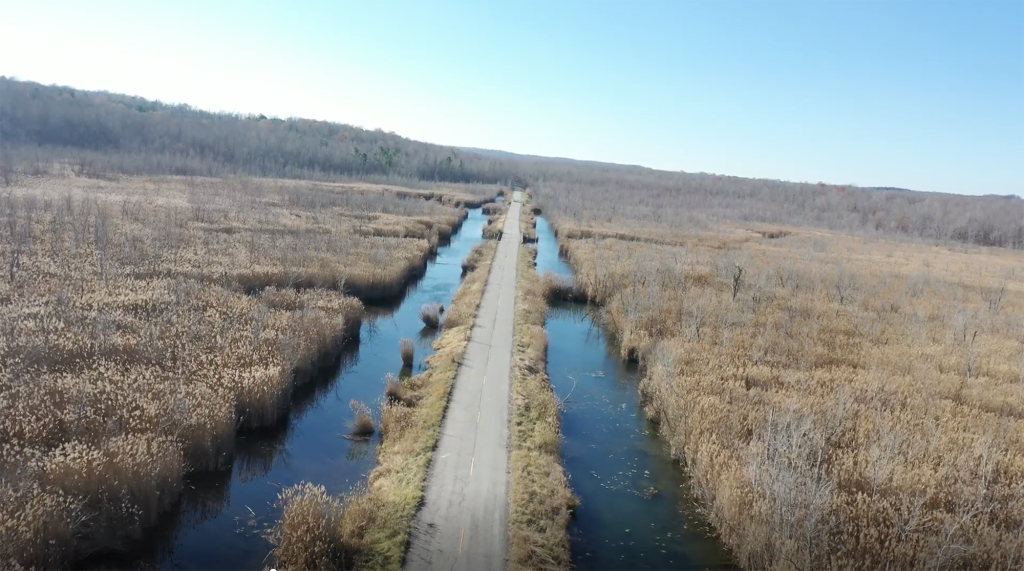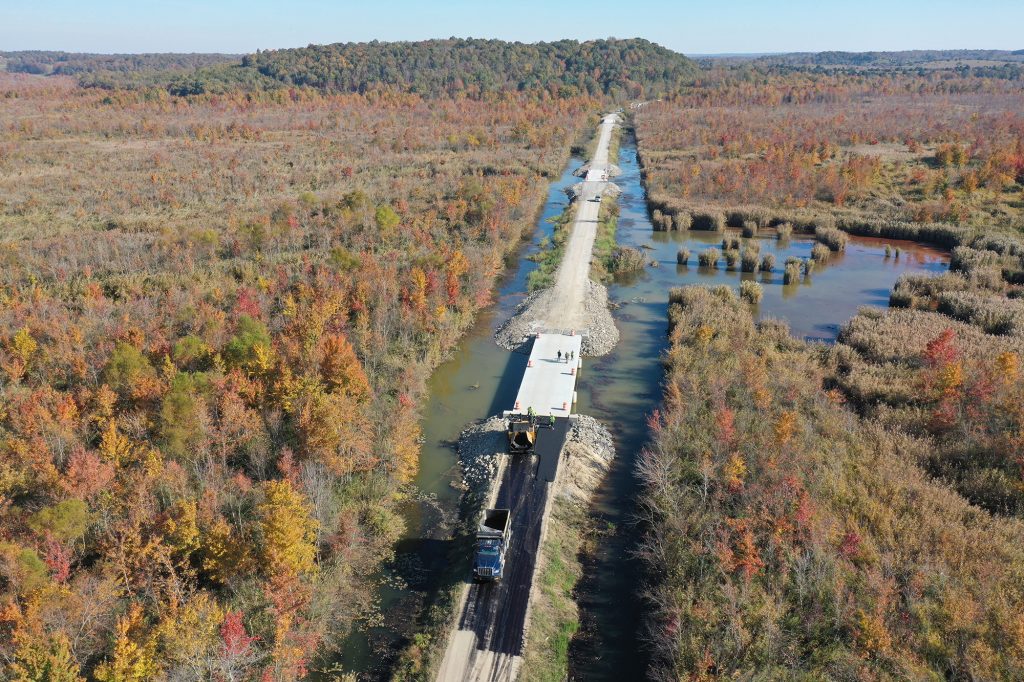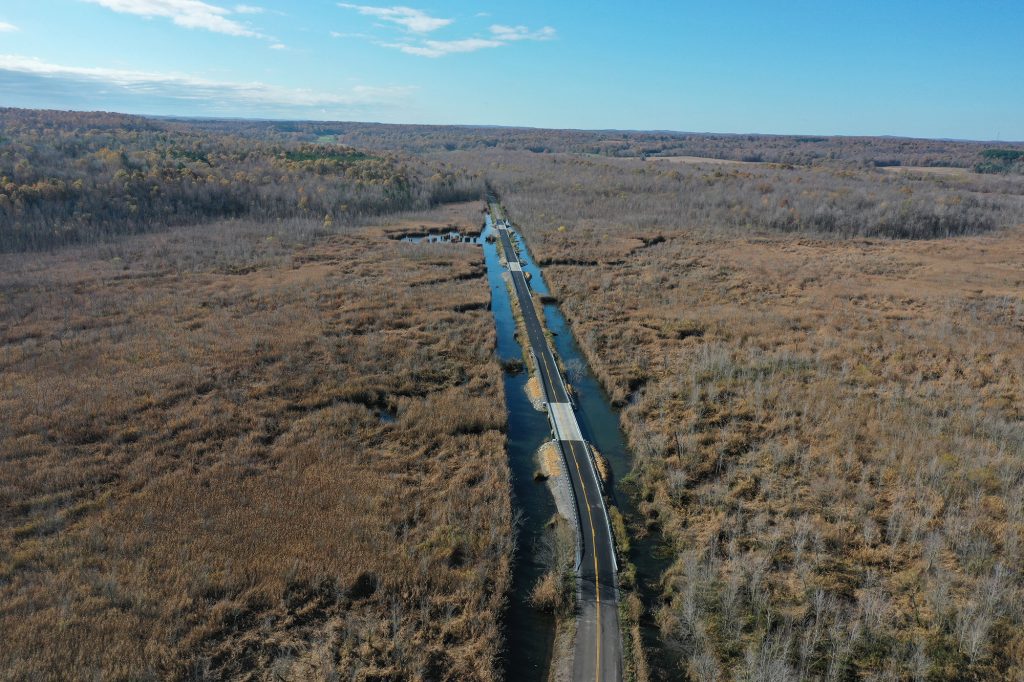Bid date: November 2023
Start date: February 2024
Completed date: November 2024
Why Awarded
Haydon Bridge Company was awarded the contract on this project because KY 502 had been closed for 3 years due to the poor condition of 3 bridges. When the project was awarded to us, the project was fully designed by the owner and ready for construction services to replace 3 bridges and approach pavement. The project size and location involved the construction of three generally identical bridges, each consisting of three spans and measuring approximately 106 feet in length. All piers required the installation of cofferdams for construction, as the bottom of each pier column was located approximately 10 feet below the normal water level.

Planning & Troubleshooting Challenges
We make it a priority to identify and address any potential challenges prior to and during construction. For this project, the site conditions presented significant difficulties, as it was located in a swamp with 4 to 6 feet of standing water and limited right-of-way for access. As a result, it was critical to develop a detailed work sequence plan to ensure efficient use of equipment and materials. Additionally, the cofferdam design had to accommodate extremely poor soil conditions, a high water table, and the need to avoid interference with the existing bridge foundations. Also, we encountered an abnormally high quantity of cottonmouth snakes on this project. Our crews had to take additional precautions due to the daily encounters with multiple snakes. These included additional lighting of the work area, snake boots & snake chaps, project mowing along the edges of the roadway and access, and due diligence of watching where you stepped.

Construction Stage
We approach each project with a structured, step-by-step plan for every phase of construction to maintain an efficient and productive schedule, with safety integrated into each stage. Construction began with the removal of the existing bridges and the simultaneous development of access routes adjacent to the bridge sites. The existing beams were carefully removed and placed at the bottom of the access path to help stabilize the underlying soil. Large limestone rocks were then laid over the beams to form the base of the access road, which was finished with #2 stone to create a suitable driving surface.
Once access was established at the first bridge location, the crew began installing cofferdams for pier construction while access development continued at the second bridge. During cofferdam installation, unexpected concrete obstructions were encountered, requiring the cofferdam configuration to be adjusted to allow for safe removal of the obstructions. After pier construction was completed and the cofferdams removed, the cofferdam equipment and materials were relocated to the second bridge, while the superstructure was built at the first bridge. This phased approach continued sequentially from the second bridge to the third.
Once cofferdam removal was completed, then the End Bents were constructed and box beams were set on the substructure. The bridge deck was constructed, then the access was removed and the approach embankments constructed. Once grade work was completed, the asphalt paving, pavement markings and guardrails were installed.
Crew & Equipment

Before construction begins, we ensure that the project is staffed with a sufficient number of qualified, skilled personnel and that all equipment is well-maintained and technologically up to date. For this project, the crew included a Superintendent, two Crane Operators, two Lead Carpenters, and an additional three to four Carpenters/Laborers, depending on the phase of construction.
Special Equipment and Processes Used:
The project required the use of:
- two 110-ton class crawler cranes,
- an ICE 44B vibratory hammer,
- a Delmag D19-32 diesel pile hammer,
- two excavators, and
- a wheel loader to support the heavy lifting, pile driving, and earthmoving operations.
Unforeseen Challenges Solved
It is not uncommon for unforeseen challenges to arise once construction is underway—issues that were not evident during the planning or estimating phases. As a result, adjustments to the initial bid may be necessary to address the evolving requirements of the project. In this case, unexpected concrete obstructions were encountered during the cofferdam installation. These obstructions constituted a changed condition that could not have been identified during the bidding process. The owner acknowledged this change, and we were able to document the associated additional costs and reach an agreement on fair compensation for addressing the unforeseen conditions.


Project Completion Overview
Upon completion of each project, we conduct a thorough review of the results, including analyzing data, photos, and video documentation from all phases of construction. This post-project evaluation allows us to continuously improve our processes, with a strong emphasis on safety enhancements. We are proud to have completed this project on schedule, despite the challenges posed by unforeseen obstructions. Additionally, we’re pleased to report that the project was completed with zero lost-time injuries—and no snake bites!
We take great pride in the fact that Haydon Bridge Company’s projects consistently contribute to the development of safe, reliable, and long-lasting transportation infrastructure, including highways, roadways, and bridges. The KY502 project is a strong example—by completing this work, we enabled the Kentucky Transportation Cabinet (KYTC) to reopen a roadway that had been closed for three years, effectively eliminating a lengthy detour for local traffic and restoring a vital connection for the community.








